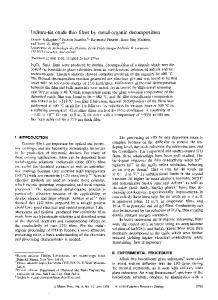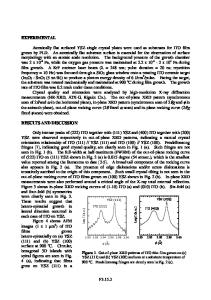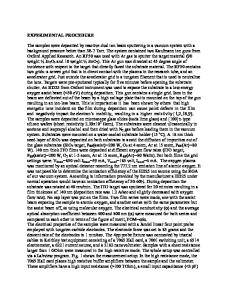Characteristics of a Reactively Sputtered Indium Tin Oxide Thin Film Strain Gage for Use at Elevated Temperatures
- PDF / 446,310 Bytes
- 6 Pages / 414.72 x 648 pts Page_size
- 28 Downloads / 360 Views
Department of Chemical and Materials Engineering, Univ. of Rhode Island, Kingston, RI 02881 ABSTRACT Strain sensors based on thin films of indium tin oxide (ITO) have been developed for a variety of applications, where the measurement of both static and dynamic strain are required at elevated temperatures. ITO thin films were prepared by rf reactive sputtering in Ar:02 mixtures from high density, electrically conductive targets having a nominal composition of 90% In203 and 10%2 2 Sn02. The resulting ITO films exhibited room temperature resistivities between 2x10- and 2x10 0• cm, an optical bandgap of 3.5 ev and tested "n" type by hot probe. These same films exhibited large negative gage factors (G=Ap/pAe) when tested at room temperature and a relatively low temperature coefficient of resistance when tested at elevated temperature in air. Specifically, gage factors approaching -100 with little hysteresis were observed for strains up to 700 gin/in and TCR's as low as 195 ppm/IC have been measured for the sputtered ITO films. In addition, these films were electrically stable and readily formed ohmic contacts with platinum at temperatures up to 1 180'C. In this paper, we report on the electrical properties and piezoresistive properties of ITO based strain gages at temperatures up to 1180'C. Prospects of using ITO thin films as the active strain elements in high temperature strain gages and the characteristics of strain sensors based on ITO are discussed. INTRODUCTION The development of advanced aerospace propulsion systems requires the measurement of both static and dynamic strain at elevated temperatures [1,2]. This is particularly true where excessive vibration and temperatures can severely affect the reliability and lifetime of engineering components. Thin film strain sensors are particularly attractive here since they do not adversely affect gas flow over the surface of a component and do not require adhesives or cements for bonding purposes [3,4,5]. These thin film devices can be deposited directly onto the desired surface by conventional sputtering techniques and thus, will remain in intimate contact with the surface of a component being deformed. Critical to the implementation of thin film strain gage technology in advanced aerospace applications is the high temperature chemical and electrical stability of the active gage element [1-5] and the magnitude of its piezoresistive response. A high temperature thin film resistance strain sensor for advanced aerospace applications based on wide bandgap semiconducting oxides has been proposed [6,7]. Alloys of indium oxide and tin oxide are particularly well suited for high temperature piezoresistive applications, where a large, reproducible gage factor (G=Ap/pAe) and a low temperature coefficient of resistance TCR = (AR/
)are combined with
excellent chemical and electrical stability. Since these oxide solid solutions are stable in air ambients at temperatures up to 1300'C, exposure to oxygen ambients does not degrade their high temperature properties. In addition, the
Data Loading...











